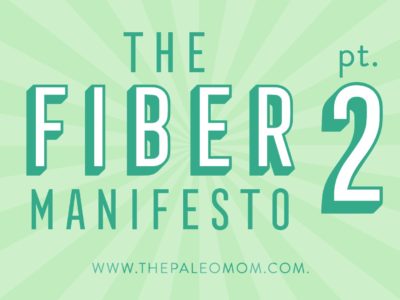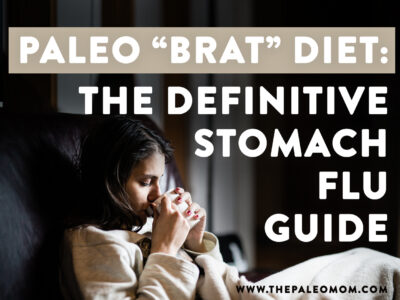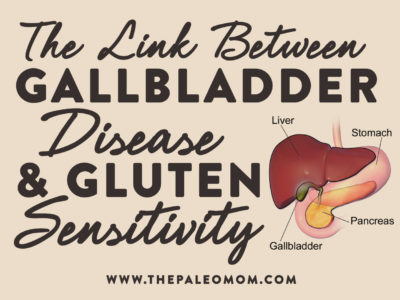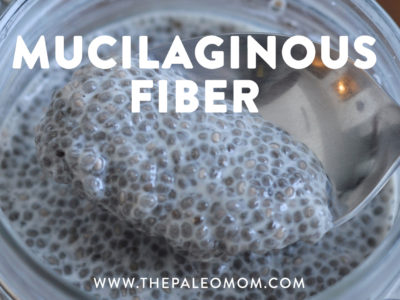Throughout the research for my first book, I kept hitting on a recurring theme. Dietary fiber is essential for good health. But I also kept hitting on pieces of information that went contrary to conventional wisdom (even contrary to conventional Paleo wisdom). Tidbits like insoluble fiber is even more beneficial than soluble (in spite of the fact that the vast majority of studies only evaluate the benefits of soluble fiber). Even more mind-blowing for me was learning that the whole insoluble fiber being abrasive thing is a myth. In fact, the deeper I delved into this subject, the more information I learned that completely challenged everything I thought I knew about this non-essential nutrient. And, the more everything started to make much more sense too.
I have been working on this series of posts for six months and am finally ready to share this information with you. I have broken this immense topic into five posts. The first post summarized some the correlative and prospective studies that have been done showing the benefits of diets rich in dietary fiber. Now for some more details, about the subclasses of fiber:
Part 2: The Many Types of Fiber (and Some Myth-Busting)
Fiber is a carbohydrate present in the cell walls of plants that our bodies can’t digest. It provides us a variety of benefits through feeding probiotic bacteria in our digestive tracts, by binding with toxins, hormones, bile salts, cholesterol and other substances in the gut, by stimulating the release of some hormones (like ghrelin) and some neurotransmitters (like melatonin) and by adding bulk to the stool (benefits of fiber were discussed in more detail in Part 1 of this series).
Carbohydrates, including fiber, are chains of monosaccharides (simple sugars) and of chemical derivatives of monosaccharides. Both the types of simple sugar (and their derivatives) in the chain and the ways they link together to form chains (both overall structure and the types of chemical bonds between sugar molecules) determine what type of carbohydrate it is. What separates fiber from other carbohydrates is that the way the sugars link together are not compatible with our digestive enzymes—our bodies just aren’t capable of breaking apart those types of molecular bonds.
Most of us are familiar with soluble and insoluble fiber, at least the terms if not the details of the definition. Broadly, soluble fiber are types of fiber that dissolve in water and insoluble fibers don’t. This greatly affects how they behave in the digestive tract.
Soluble fiber forms a gel-like material in the gut and tends to slow the movement of material through the digestive system. Soluble fiber is typically readily fermented by the bacteria in the colon (although not all soluble fibers are fermentable), producing gases and physiologically active by-products (like short-chain fatty acids and vitamins).
Insoluble fiber tends to speed up the movement of material through the digestive system. Fermentable insoluble fibers also produce gases and physiologically active by-products (like short-chain fatty acids and vitamins). Nonfermentable insoluble fiber increases stool bulk by absorbing water as it moves through the digestive tract (which is believed to be very beneficial in regulating bowel movements and managing constipation).
Within these two broad categories, there are actually many different types of fiber, classified based on the types of simple sugars and other components they are made from, the types of bonds between sugars, and the overall structure of the molecule. The major classes of fiber will be discussed in more detail below, but this is how they divide among the soluble versus insoluble categories:
 Depending on the food in question, some foods have more insoluble fiber types and some have more soluble.
Depending on the food in question, some foods have more insoluble fiber types and some have more soluble.
However, classifying a fiber as either soluble or insoluble is only one way to describe a particular fiber. They can also be classified based on whether or not they are fermentable (if they are, they are considered to be “prebiotics”, which just means that they are food for the bacteria that live in our digestive tracts). While soluble fibers have the reputation of being the fermentable fibers, there are plenty of types of insoluble fiber which are fermentable as well and even some types of soluble fiber which aren’t fermentable (or are only weakly fermentable). Fibers can also be classified based on whether or not they are viscous, meaning how thick they are when they mix with water and other substances in your digestive tract (this classification is used to classify soluble fibers because insoluble fiber doesn’t dissolve in water). Many of the health benefits of soluble fiber are specific to high viscosity fibers (more on this in part 3). Functional fiber is the term for an isolated fiber used as a supplement.
The fibers discussed in more detail below can also be categorized based on whether or not they are fermentable:
 You might be surprised to see that most types of fiber are actually fermentable (some more readily than others, of course)… not just soluble fiber. I want to point this out because it’s a myth that soluble fiber is “the fermentable kind of fiber”.
You might be surprised to see that most types of fiber are actually fermentable (some more readily than others, of course)… not just soluble fiber. I want to point this out because it’s a myth that soluble fiber is “the fermentable kind of fiber”.
As already mentioned, there are actually many types of fiber (which are then either lumped into the soluble or insoluble categories or lumped into the fermentable or nonfermentable categories). And, it turns out that if you want to understand what types of fiber (or whole food sources of fiber) are most beneficial for you, you actually need to go into far more detail than just whether a fiber is soluble or insoluble.
The main classes of fiber:
Cellulose is the main component of plant cell walls. Celluloses are identical to starch in the sense that they are long straight chains of glucose molecules (anywhere from several hundred to over ten thousand glucose molecules long), however the links between the glucose molecules are different than starch (they are in what is called a beta configuration) which make cellulose indigestible to humans. Celluloses are insoluble dietary fibers. The bacteria in your intestinal tract cannot ferment most cellulose particularly well (although cellulose is partially fermentable). Cellulose is found in all plants, but foods that contain particularly large amounts of cellulose include bran, legumes, nuts, peas, root vegetables, celery, broccoli, peppers, cabbage and other substantial leafy greens like collards, and apple skins.
Hemicellulose is a common component of the cell walls of plants. In contrast to cellulose, hemicellulose is made of several types of sugar in addition to glucose, especially xylose but also mannose, galactose, rhamnose, and arabinose. Rather than forming long straight chains like cellulose, hemicellulose may have side chains and branches. Because of these variations, some hemicelluloses are soluble in water and some are insoluble, plus some forms are fermented by bacteria while others are not. Hemicellulose is particularly high in bran, nuts, legumes and whole grains as well as many green and leafy vegetables.
Pectin is soluble in water and highly fermentable (very little passes through to the colon since it is so readily fermented by bacteria in the small intestine). Pectins are rich in the sugar are rich in galacturonic acid and can be found in several types of configurations (further subdividing this class of fibers by structure). Pectins are found in all fruits and vegetables but are particularly rich in certain fruits, including apples and citrus fruits, and are also found in legumes and nuts.
Lignin is a type of fiber with lots of branches made of chemicals called phenols (rather than sugar molecules). Phenols are currently being studied for a variety of health-related effects including antioxidant actions (for example, it is the phenolic compounds in olive oil that appear to be responsible for its cardiovascular health benefits). Lignin is unusual because it lacks an overall defining structure. Instead, it consists of various types of substructures that appear to repeat in a haphazard manner. Lignins are insoluble and are not fermentable. Most commonly a component of wood, food sources include root vegetables, vegetable filaments (like the stems of leafy greens and the strings in celery), many green, leafy vegetables, wheat and the edible seeds of fruit (such as berry seeds and kiwi seeds).
An aside: Hemicellulose, cellulose, and pectin bind together to from a network of cross-linked fibers and together form the cell wall of most plant cells. Lignin fills the spaces in the cell wall between cellulose, hemicellulose, and pectin components. You get some form of all four of these whenever you eat any plant-based food.
Chitin is similar to cellulose in the sense that it is made of long chains of glucose (in the case of chitin, it’s actually long chains of a particular derivative of glucose called N-acetylglucosamine) and also has amino acids attached. Chitins are insoluble in water and are fermentable, albeit weakly. Chitin is interesting because this fiber is found not only in plants and fungi but also in the exoskeletons of insects and in the shells of crustaceans.
Chitosan is similar to chitin in the sense that is composed of a long chain of N-acetylglucosamine molecules, but it also contains randomly distributed D-glucosamine molecules (like cellulose, linked in a beta configuration). Chitosans are naturally found in the cell walls of fungi but are also produced as a functional fiber by treating shrimp and other crustacean shells with sodium hydroxide. Chitosan is a very unique fiber. It is soluble in acidic environments so it starts its journey through the digestive tract as a soluble fiber in the stomach, but when the acidity of the chime (stomach contents) is neutralized in the small intestine (by pancreatic secretions), it becomes insoluble. It is also fermentable (much moreso than chitin).
Gums are a diverse group of fibers that plants secrete when they are damaged. They are very complex molecules that contain a variety of types of sugars as well as acids, proteins, and minerals. Gums are soluble and highly viscous fibers and are also fermentable. Isolated (functional fiber) versions are used in food manufacturing as thickening and gelling agents (like guar gum and xanthum gum). Some gums used in food manufacturing increase intestinal permeability through an action on the tight junctions between epithelial cells (one of those cases of the isolated concentrated compound being a problem but the small amount naturally occurring in whole foods being fine).
Beta-glucans (more technically Beta(1,3)-glucans) are closely related to gums and are also soluble (a minority are insoluble), viscous and fermentable. They are found in some grains (mainly oats and barley, but also rye and wheat), fungi (yeast and mushrooms, particularly those mushrooms that are used medicinally like shiitake and maitake), and some types of seaweed (mainly algae). Beta-glucans are the fiber in oats that are mainly responsible for the cholesterol lowering properties of oats (more on this in part 4 of this series) and, as functional fibers in supplement form, are also known to activate the immune system and may even act as an adjuvant (that could be helpful if you’re battling cancer but definitely not good if you have an immune or autoimmune disease).
Mucilages are rich in the simple sugars xylose, arabinose, and rhamnose and have very complex structures. They are soluble and very viscous fibers, forming a thick gluey substance, and are produced by nearly all plants and some microorganisms. They are particularly concentrated in cacti and other succulents (like aloe), many types of seaweed (like agar agar algae), flax, chia and psyllium. They can also be found in relatively large amounts in a variety of fruits and vegetables, including plantains, bananas, taro root, cassava, and berries. While soluble, mucilages are not particularly fermentable (only partially degraded by bacteria in our digestive tracts). Mucilagenous extracts are often used medicinally, and many of these extracts are known immune modulators or stimulators.
Fructans are fructose rich soluble and highly fermentable fibers with simple structures (long chains, some with branches–like the fructose equivalent of cellulose). Shorter chain fructans are called fructooligosaccharides, whereas longer chain fructans are called inulins. Inulin fiber is one of the most heavily studied functional fibers. They are naturally occurring in a variety of plants including chicory, onions, and Jerusalem artichoke (see FODMAPs).
Resistant starch is really starch (also sometimes called oligosaccharides) and doesn’t fit the original technical definition of fiber, which was limited to plant cell wall constituents. Resistant starch is considered to be a fiber because amylase, the enzyme that breaks starch into individual glucose units, doesn’t work on this type of starch. Resistant starch is insoluble yet highly fermentable. Green bananas, green plantains, potatoes and legumes are all sources of resistant starch (particularly when eaten raw).
Phewf. Would you believe that these are only the major classes of fiber?
Most of these types of fiber can be further divided into sub-sub classes of fiber. They are almost all found to some degree in almost all plants, so when you eat whole vegetables, fruits, nuts and seeds, you’re getting a mix of many of these. You’re also getting different forms: the cellulose in an apple peel is different than the cellulose in cabbage and this may have a slightly different effect in your digestive tract (like so many things in biology/physiology/nutrition, the details have yet to be worked out).
So now that we understand the complex world of dietary fiber, we can have some real fun! Stay tuned….
Dikeman CL and Fahey GC. Viscosity as related to dietary fiber: a review. Crit Rev Food Sci Nutr. 2006;46(8):649-63.
Nondigestible Carbohydrates and Digestive Health. Edited by Teresa M. Paeschke, William R. Aimutis (2011) John Wiley & Sons.
Handbook of Dietary Fiber. Edited by Susan Sungsoo Cho (2001) CRC Press.
Nutritional Sciences: From Fundamentals to Food. Edited by Michelle McGuire and Kathy A Beerman. (2011) Cengage Learning.
Shim JH, et al Antitumor effect of soluble beta-1,3-glucan from Agrobacterium sp. R259 KCTC 1019. J Microbiol Biotechnol. 2007 Sep;17(9):1513-20.












